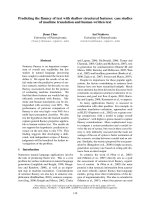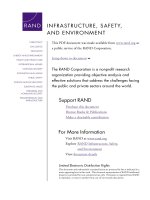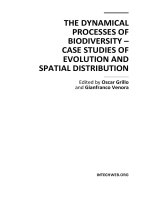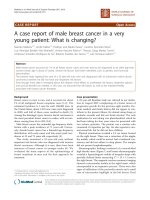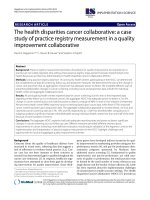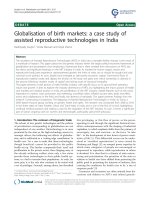Representing asian ness through contemporary dance case studies of five dance companies in singapore
Bạn đang xem bản rút gọn của tài liệu. Xem và tải ngay bản đầy đủ của tài liệu tại đây (1.4 MB, 253 trang )
REPRESENTING ASIAN-NESS THROUGH
CONTEMPORARY DANCE: CASE STUDIES OF FIVE
DANCE COMPANIES IN SINGAPORE
CAREN CARINO
B.Ed. and M.F.A. (Dance), University of Hawaii
A THESIS SUBMITTED
FOR THE DEGREE OF DOCTOR OF PHILOSOPHY
SOUTHEAST ASIAN STUDIES PROGRAMME
NATIONAL UNIVERSITY OF SINGAPORE
2008
A
cknowledgements
I would like to thank the following people for their inspiration, invaluable
guidance and support in the research and writing of my thesis. I am indebt to the
contemporary dance companies and dance artists based in Singapore at the time of
my research. It is because of these individuals and their creative work that
compelled me to write this thesis: Angela Liong (artistic director), Elysa Wendi
(assistant artistic director) and Scarlet Yu (dancer) from The Arts Fission
Company; Lim Chin Huat(artistic director) , Tan How Choon (associate artistic
director) and Su Sam (dancer) from Ecnad Project Ltd.; Tammy Wong (artistic
director) and Elaine Chan (dancer) from Tammy L. Wong Dance Company;
Danny Tan (artistic director), Sylvia Yong (dancer) and Albert Tiong (dancer)
from Odyssey Dance Theatre and; Aaron Khek Ah Hock (executive director), Ix
Wong Thien Pau (artistic director) and Ebelle Chong (dancer) from Ah Hock and
Peng Yu.
I embarked on the writing of this thesis as a dancer accustomed to creative
and physical expression. However, through the patience and guidance of my Ph.D.
supervisor Associate Professor Goh Beng Lan and the careful scrutiny of Hannah
Tan, I have gained an immense respect for critical thinking and written
expression.
I am grateful to my mentor Joan Woodbury and all my dance friends and
colleagues for their words of wisdom and encouragement: Ravenna Tucker, Lim
Fei Shen, Professor Patricia Adams, Dr. Brian Howard, Professor Judy Van Zile,
Dr. Stephanie Burridge, Associate Professor Cheryl Stock and Dr. Siri Rama. I am
i
also thankful to the many dancers that have shared their experiences and insights
including my students Vincent Yong, Zhou Zihao, Lee Mun Wai, Law Su Ling
and Choo Ting.
Finally, I would like to thank my family - husband James Andrew
Weschler and sons James Anthony Carino (Jac) and Andrew Bradford Carino
Weschler for their love and support. I especially want to thank my parents
Antonio Collado Carino and Frisca Blaquera Carino for encouraging me to pursue
my dreams and aspirations in life. It is because of their firm belief in me that I
enjoyed and continue to pursue a wonderfully full and rewarding life in dance as a
performer, educator, administrator, advocate and academic.
ii
Table of Contents
Title Page
Acknowledgements i
Table of Contents iii
Summary vii
Illustrations x
Chapter One: Introduction 1
Personal Location 3
Description of Fieldwork and Data Collection 10
Structure of the Thesis 13
Chapter Two: Background 16
Introduction 16
Western Modern Dance 16
Terms: Modern Dance and Contemporary Dance 22
Asian Contemporary Dance: Western Modern Dance
Transplanted in Asia 26
Contemporary Dance in Singapore 28
Conclusion 41
Chapter Three: Analytical Framework 43
Introduction 43
Survey of Scholarship and Discourse on Local Identity:
Asian Values and Asian-ness 45
iii
Asian Contemporary Dance: Approaches in Creation 57
Interculturalsim 57
Multidisciplinarism 73
Body-Centeredness 77
Conclusion 83
Chapter Four: The Arts Fission Company 86
Introduction 86
Angela’s Personal Search 87
Interculturalism Linked with Multidisiciplinarism 90
Current Issues as Themes 95
Elysa’s Background and Shared Vision 104
Conclusion 108
Chapter Five: Ecnad Project Ltd. 110
Introduction 110
Chin Huat’s Influences and Approach 112
How Choon’s Influences and Approach 114
Artistic Expression through Western Forms and
Multidisciplinarism Rooted in Western Practice 115
Dance as an Expression of Contemporary Issues 126
Conclusion 130
Chapter Six: Tammy L. Wong Dance Company 132
Introduction 132
Influences on Tammy’s Identity and Artistic Approach 134
Western-centric Artistic Expression 144
iv
Conclusion 153
Chapter Seven: Odyssey Dance Theatre 155
Introduction 155
Danny’s Personal Identity and Vision 157
A Hybrid Dance Form through Interculturalism 161
Aesthetics, Sentiments and Beliefs 166
Conclusion 170
Chapter Eight: Ah Hock and Peng Yu 172
Introduction 172
Aaron’s Background and Influences 174
Ix’s Background and Influences 181
Body-Centeredness as an Approach to Understanding 183
Asian-ness
Multidisciplinarism in the Expression of the Contemporary 191
Asian Identity
Consistency of Asian Themes 198
Conclusion 201
Chapter Nine: Conclusion 203
Bibliography 210
Appendices: Dance Company Profiles 218
Appendix I: The Arts Fission Company 219
v
Appendix II: Ecnad Project Ltd. 225
Appendix III: Tammy L. Wong Dance Company 230
Appendix IV: Odyssey Dance Theatre 234
Appendix V: A Hock and Peng Yu 238
vi
Summary
Dance has rarely been looked at as a repository site for discourses on
nationalist or regional identities in Southeast Asia. Somehow there has been more
focus on culture, politics and identity in theatre and other performing arts rather
than dance. Hence, in an endeavor to fill this gap this thesis looks at how
contemporary dance is a dynamic space where Asian identity takes on complex
and meaningful constructions through the lives and work of contemporary Asian
dance artists located in Singapore.
This thesis contends that contemporary dance, an aesthetic expression, is
an important site to analyze the construction and meanings of Asian identity in
parallel to social scientific analyses of nationalist and Southeast Asian identities,
which have amongst other things, centered on the “Asian values and identities”
discourse in Southeast Asia. Although the search for the “local” and “indigenous”
has always characterized Southeast Asian scholarship, focus on a broader Asian
identity began with the rise of the region and assertion of difference from the West
promoted through the “Asian values” discourse since the late 1980’s. Social
scientific analyses of the Asian identity discourse in Southeast Asia tend to
relegate Asian values as elitist, if not nationalist, constructions. For instance, the
discourses on Asian values are viewed as elitist identity politics such as in the
context of Singapore where the then prime minister, Lee Kuan Yew, used an
Asian identity, particularly Chinese values and beliefs, to define the Singaporean
identity. While this thesis acknowledges the political strategy of the state and
elites in the construction of an Asian identity, it argues that not all constructions
can be reduced to elitist or state instrumentality.
vii
An in-depth investigation of the works and lives of eight artistic
directors/choreographers from 1994 to 2005 under the auspices of five Singapore-
based contemporary dance companies saw them assuming a significant role in
defining “Asian-ness” in their own way. These dance artists were seen to be
influenced by their personal biographies, which were a result of cultural heritage,
acculturation as well as sojourns and exposure. The work they produced centered
around unresolved tensions between prioritizing cultural continuity and/or
particularity as well as the uncritical acceptance of Western outlooks. This study
shows that Singapore, with its historical, geographical, political and
demographical particularities, becomes a conducive and meaningful place for both
local Singaporeans as well as immigrants such as Asian Americans and Southeast
Asians, particularly those of Chinese or part-Chinese descent, to live and create
their Asian contemporary dance forms. The space created by the Asian values and
identities debates coincides with the visions and struggles of the Asian-artist
diaspora that are not necessarily defined and contained by Singapore’s nationalist
ideology.
For many of these artists, at times Asian-ness is understood as a specific
Asian culture associated especially with Chinese ethnicity, which is thought to be
both intrinsic as well as something learned. At other times, however, it is not
necessarily about ethnicity but embracing multiple Asian cultural influences, i.e.
reflecting different local contexts of various Southeast and East Asian societies
such as Malaysian, Indonesian, Korean, etc. Yet in other instances, Asian-ness is
not about a particular Asian ethnicity but more about acculturation with, or
influenced by values, ways and aesthetics associated with Western societies.
viii
Furthermore, towards the creation of various Asian contemporary dance
forms, three approaches were identified: interculturalism, multidisciplinarism and
body-centeredness. While these three approaches are also found in Western as
well as Southeast Asian performance creations or somatic practices, more
important was the way in which they were utilized by contemporary Asian dance
artists towards reclaiming contemporary dance as an Asian form, or on Asian
terms, to establish representational difference in today’s world. Through these
approaches, contemporary dance is transformed from a Western form into an
Asian form. Called “Asian contemporary dance” in this thesis, it expresses Asian
themes, has a hybridized mixture of Asian/Western movement vocabularies, a
combination of Asian/Western multidisciplinary artistic collaborations as well as
Asian translations of Western technique and approaches in dance creations.
Hence, this thesis shows that the realm of contemporary dance is a site
where diverse and complex interpretations of Asian-ness are embodied. While the
discourse of Asian identity is a Singapore nationalist doctrine, Asian-ness could
not be contained solely within the nationalist framework because both local and
migrant artists who live in Singapore have their own sense and meaning of Asian-
ness that extends the discourse of Asian identity debates beyond nationalist
definitions. This thesis argues that Asian-ness need not take the form of political
or elitist rhetoric alone, but is also about the expression of multi-faceted
imaginings of individual or collective differences about ethnicity, community,
heritage and culture through artistic agency.
ix
Illustrations
1. Urban Sanctuary. The Arts Fission Company. The Arts Magazine.
Singapore, March- April 2001. 96.
2. Imagine Forest. The Arts Fission Company. The Arts Magazine.
Singapore, September -October 2001. 97.
3. 12 SMS Across the Mountains. Photographer: Ji Won Yoo. 12 SMS
Across the Mountains. Program booklet. Singapore, 2005. 102.
4. Lost Light I: Syonan Jinja Shrine. The Arts Fission Company. Publicity
packet. Singapore, 2003. 103.
5. Siau Ling: Timeless Living. The Arts Fission Company. Publicity packet.
Singapore, 2003. 107.
6. Intimate Letters. Photographer: Watson Lau. The Arts Fission Company.
Publicity packet. Singapore, 2004. 108.
7. Crazy Naked World. Photographer: Urg Ruey Loon. Seven Years in a
Night. Program booklet. Singapore, 2003. 120.
8. Fantasy Creatures & Other Things. Photographer: Lim Suon Oon. Seven
Years in a Night. Program booklet. Singapore, 2003. 121.
9. Fantasy Creatures & Other Things. Photographer: Lim Suon Oon. Seven
Years in a Night. Program booklet. Singapore, 2003. 122.
10. Crazy Naked World. Photographer: Urg Ruey Loon.
Seven Years in a
Night. Program booklet. Singapore, 2003. 123.
11. A-the-bird. Photographer: Melinda Ng.
The Arts Magazine. Singapore,
November- December 2000. 124.
12. Floating Mirror. Photographer: Lim Suon Oon.
Seven Years in a
Night. Program booklet. Singapore, 2003. 127.
13. Missing in Tall Pillars. Photographer: Tan Giap Heng. Seven Years in a
Night. Program booklet. Singapore, 2003. 128.
14. Ego Flamingo. Ecnad Project Ltd. The Arts House. Events calendar.
Singapore, 2004. 129.
15. Floating Mirror. Photographer: Sim Tiak Siew.
Selves: The State of the
Arts in Singapore. Singapore, 2002. 129.
16. Remembering Jesus. Tammy L. Wong Company. Selves: The State of the
Arts in Singapore. Singapore, 2002. 146.
x
17. Cry. Tammy L. Wong Dance Company. The Arts Magazine. Singapore,
May-Jun 2002. 147.
18. Folk Song. Tammy L. Wong Dance Company. The Arts Magazine.
Singapore, May-June 2002. 150.
19. Journal. Tammy L. Wong Dance Company.
Selves: The State of the Arts
in Singapore. Singapore, 2002. 151.
20. Rain. Tammy L. Wong Dance Company. The Arts Magazine. Singapore,
May-June, 2002. 152.
21. Synesthesia. Odyssey Dance Theatre Ltd. Singapore, 2005.
22. Innocent Light. Odyssey Dance Theatre Ltd. Singapore, 2002.
23. Ah Hock and Peng Yu. Arts Awards 2005. Program booklet. Singapore,
2005. 193.
24. Ah Hock and Peng Yu. The Arts Magazine. Singapore, July-August, 2003.
198.
25. Bowl of Containment. Ah Hock and Peng Yu. On Point 2
nd
Issue.
Singapore, 2002. 201.
xi
Chapter One: Introduction
This thesis investigates how contemporary dance is a site for various
expressions of the Asian identity in Singapore through the lives and choreography
of eight dance artists under the auspices of five Singapore-based contemporary
dance companies from 1994 to 2005. (A profile of each company is found in
Appendix I –V). The peak of the “Asian values” discourse in the 1990’s, while
considered contrived and politically driven on one level, coincides with the
emergence and development of Asian contemporary dance in Singapore and finds
dance artists consciously constructing and reflecting “Asian values” in their
choreography. This research shows how Asian contemporary artists are serious in
asserting their contemporary Asian identity by drawing on cultural ethnicity and
heritage, yet also embrace Western expressions through exposure. Their different
views of the Asian identity represent a range of unresolved tensions including
prioritizing cultural continuity as well as the uncritical acceptance of Western
outlooks and are reflected in the creation of Asian contemporary dance forms
utilizing interculturalism, multidisciplinarism and body-centeredness as creative
frameworks.
Although Asian identity issues have been discussed at considerable length
in the fields of anthropology, history, geography and cultural studies at both elitist
and popular levels in Southeast Asian societies, less attention has been given to
their study in the performing arts, much less contemporary dance. While
contemporary dance is recognized as a viable medium of cultural identity, there is
little research, if any, with regards to contemporary dance and its connection to
Singapore’s cultural or Asian identity. Contrary to dance, there has been more
1
focus on linking theatre and cultural identity issues in Singapore. Thus, this thesis
aims to fill this gap and show that contemporary dance produced by Asian dance
artists located in Singapore, otherwise called Asian contemporary dance forms are
aesthetic representations of the historical, social and political context from which
they have emerged. Various constructs of “Asian-ness”, which may or may not be
complicit with Asian identity and values discourse, are also simultaneously
developments from both within and without, i.e. external forces such as
globalization, internal dynamics such as the Ministry of Information and The Arts
manifesto on becoming a Renaissance City, and agency or the personal
biographies, locations and sojourns of the individual dance artists.
The local dance scene has gained momentum but documentation of its
development and study of its cultural significance and implications are lagging
behind. I have not known of any Singapore-based scholars who have produced
academic work on dance in Singapore as extensively as Chua Soo Pong, who has
published books, monologues and articles.
1
Chua belongs to a group of Asian
dance writers who have produced a broad perspective on dance in Southeast Asia
utilizing a flexible and multidisciplined approach. These writers include
indigenous Asian dance scholars educated abroad in the United States and the
United Kingdom.
2
Equipped with the knowledge and skills of anthropology,
kinetography, Labanotation,
3
ethnomusicology and ethnochoreology,
4
they have
endeavored to document and describe the multitude of indigenous dances in
1
Ad hoc articles and reviews as well as papers have been produced by Singapore-based writers on
dance in Singapore but not a body of work like Chua’s.
2
Among the scholars who have written in-depth accounts on dance in Southeast Asia are
Mohamed Anis Md Nor on Malaysia and Basilio Esteban S. Villaruz on the Philippines.
3
Kinetography and Labanotation are terms used by practitioners to describe a kind of movement
script first developed by Rudolph Laban in 1928 and is continuing to develop.
4
Ethnomusicology and ethnochoreology refer to the theoretical and practical study of music or
dance respectively in their cultural context. While ethnomusicology is considered the anthropology
and ethnology of music, ethnochoreology is thought of as the anthropology and ethnology of
dance.
2
Southeast Asia as well as discuss the development of dance in Southeast Asia in a
cultural context. Their writing is “Asia-centric”,
5
i.e. written by and about Asians
with a strong interest to preserve established cultural ideologies. Thus, Chua’s
work focuses on traditional and cultural dance forms, particularly Chinese dance
and Chinese opera. However, to date, an in-depth account of contemporary dance
in Singapore has not been published, much less studied as an expression of
Singapore’s contemporary culture. It is the aim of this thesis, therefore, to fill this
gap.
Personal location
My interest in investigating the topic of Asian-ness expressed through
contemporary dance began ten years after I came to Singapore with my husband
to live and work in 1992. When I first arrived I was representative of the typical
American expatriate (“expat”) who viewed Singapore as a temporary destination
with sights of returning to America one day soon. However, unlike many expats,
my husband and I were not on a company contract; instead we had our own
business so our tenure in Singapore was not fixed and when our business direction
changed in 1997 I became more involved in the contemporary dance scene, first as
a substitute lecturer, then part-time lecturer, assistant associate head and
eventually Head of Dance (1997- Nov 2004) at LASALLE-SIA College of the
Arts. During these years my perspective and different roles in the contemporary
dance scene in Singapore intensified. As my position at LASALLE-SIA became
more involved I also committed myself to other areas of developing contemporary
dance in Singapore including being advisor with government bodies – National
5
The term denotes the debates on Asia-centric scholarship argued by John Smail. Smail
considered the autonomous history of Southeast Asia the domestic stories of the region from an
Asian perspective.
3
Arts Council (NAC), Ministry of Education (MOE) and People’s Association
(PA), initiating and directing several contemporary dance projects, designing
curriculum centered on contemporary dance, as well as writing numerous articles
and reviews for local publications. I also got to know, both formally and casually,
many contemporary dance artists and seen numerous contemporary dance
performances. In other words, I became more than familiar with the contemporary
dance scene in Singapore; I had become entrenched.
Furthermore, through my deepening involvement I began to see that
contemporary dance in Singapore and Asia was different than what I experienced
in America. Up until this point, I understood contemporary dance (also referred to
as modern dance) primarily as a Western construct because of my background and
training in the USA which included my initial training in the Humphrey-Limon
modern dance technique based on “fall and recovery” with Betty Jones, one of the
pioneer dancers with the Jose Limon Dance Company.
6
I then expanded my
training in the post-modern “movement-for-movement’s sake” dance style based
on the concepts of time, space, shape, energy and motion, developed by American
post-modern dance pioneer Alwin Nikolais. Following my training I went on to
dance with the Ririe-Woodbury Dance Company
7
whose repertoire was an
eclectic mix of post-modern styles by choreographers including Alwin Nikolais,
Murray Louis, Kei Takei, Bill Evans, Tandy Beal,
8
among others. Hence, for me
and many Western-based artists, contemporary dance was a Western expression
6
The Jose Limon Dance Company was founded by Jose Limon, a student of Doris Humphrey, in
1946. Humphrey was the company’s first artistic director and helped Limon to develop his
repertory and technique/style. Chapter 2 gives more background information on the development
of contemporary/modern dance.
7
Ririe-Woodbury Dance Company is a contemporary dance company based in Salt Lake City,
Utah, and was founded by Joan Woodbury and Shirley Ririe in 1964.
8
Each of these choreographers had their own characteristic style: Nikolais produced multi-media
spectacles; Louis injected wit; Takei played with pedestrian movement and Beal theatricality.
4
that emerged during the cultural era known as modernism (1890-1945) in the
West and continues to evolve. Each subsequent generation of modern dancers,
like their predecessors, have challenged what went before and reflected their own
concerns and issues. Dance critic Jack Anderson says:
Since America has often liked to call itself a nation ‘on the
move,’ it could be argued that modern dance represents one
way of channeling the energy for which Americans are
famous. Modern dance can also be said to exemplify both
American self-reliance and, in its creatively permissive
spirit, American ideals of democracy and nonconformity.
9
Modern dance in America was linked to American nationalism, often
couched in the term “patriotism”. However, what I observed in Singapore during
the 1990’s was the discourse on nationalism of a somewhat different kind – it did
not refer to a Singaporean identity as much as appeal to a larger Asian identity. In
Singapore what I observed was the transformation of Western contemporary
dance into new Asian contemporary dance explorations and forms. Western
contemporary dance technique has over the years been transferred through
expatriates like myself who settled in Singapore, visitors or Singaporeans who
have studied dance in the West, but I observed that instead of perpetuating
contemporary dance as a Western tradition, it was often incorporated in broader
association with Asian themes and other Asian elements, rather than a more
particular Singaporean identity, towards the creation of new contemporary dance
forms. These contemporary dance forms, therefore, seemed to assert various
9
Anderson, Jack. “Phoenix of Modern Dance”. Ballet and Modern Dance: A Concise History
(Second Edition). Dance Horizons: New Jersey, 1992. 172.
5
constructs of the Asian identity utilizing contemporary dance as one of the
expressions.
While I recognized this to be happening in the local contemporary dance
scene, I questioned my own practice as a dancer, choreographer, dance educator
and administrator. I saw that there was a need to caution myself about the
transference but also verification of contemporary dance only through a Western
perspective. It could not be assumed that even if Westernization seemed to be
overtly embraced it was in totality. Instead, I saw that contemporary dance was
taken seriously by local dance artists as a vehicle to explore and express
difference through an Asian identity. It was in this context that I also reviewed my
own cultural identity, artistry and sense of responsibility of developing dance in
Singapore as an Asian American artist and teacher.
To begin, my sense of personal cultural identity is complex. I am a second
generation Asian American, born in culturally diverse Hawai’i, the 50
th
state of
the USA. I am of Asian ethnicity (i.e. Filipino/Spanish from my father and
Filipino/Chinese from my mother), acculturated in mainstream American culture
but also embracing what could be referred to as sub-cultures of the Asian,
Polynesian and Hispanic populations. My family only spoke English, observed
American traditions and customs such as Thanksgiving, Halloween, Easter,
President’s Day, etc., enjoyed American sports like football, basketball and
baseball, ate American food, and I learned to play the piano and flute. However,
because Hawai’i is a melting pot of several ethnic groups I was exposed to
Filipino, Hawaiian, Portuguese and Chinese traditions and customs, among other
cultural groups, primarily through my family as well as through formal education
and state celebrations and festivities. In particular, I experienced my Filipino
6
heritage through the food my parents prepared, the attendance of Filipino
celebrations, listening to my parents sing with their Filipino choral group as well
as viewing Filipino Fiesta, a popular Filipino television variety show. I also
absorbed other cultures like Portuguese, Chinese and Hawaiian cultures through
the marriages of my immediate family members as well as my own marriage to a
Caucasian man with direct lineage to America’s founding forefathers. In other
words, I describe my cultural identity as subscribing to mainstream American
ideals yet belonging to a Filipino ethnic heritage as well as acknowledging other
Asian, Polynesian and Hispanic influences.
Although I also consider my personal dance artistry as primarily Western
since, as I mentioned earlier, my dance training and exposure was in Western, i.e.
American, contemporary dance techniques and styles, I have also ventured on
occasion into interculturalism, i.e. experimenting with bringing different cultural
aspects together through dance. On one hand I believe that contemporary dance is
universal in conception as well as expression, and I often explore the concepts of
time, space, shape and energy, and/or deal with emotional states resulting from
my own unresolved issues such as feeling lost, exiled and isolated, fear of death,
etc. However, there is also another part of me that yearns to express my complex
cultural identity. One of the few instances in which I explored the possibility
expressing my personal cultural background was through my Masters of Fine Arts
thesis project in a series of dance videos comprised under the title Sojourns
(1988). “Oneness” looked at my Asian side through a work that exemplified what
I believed to be virtues embraced by East Asian philosophy such as “order,
balance, peace, inner strength, unselfishness and tolerance”,
10
set against a
10
Carino, Caren. Sojourns. Notes. Hawai’i, 1988.
7
backdrop of projected images from China. In “Kai Malie-Kai Ko’o-Kai Malie”,
translated as “Calm Sea-Rough Sea-Calm Sea”, I performed in the serene tidal
pools as well as pounding surf in Hawai’i to a Hawaiian chant performed live. I
wrote in my notes about the piece:
A woman embarks on an emotional journey. She walks
along the shoreline of an island contemplating the
surrounding beauty but also feels isolated. These mixed
feelings turn into frustration. Her turmoil ends when she
finds a shell on the beach. She is captivated by it. The shell
lulls her into a deep sleep. Literally [as she is gradually
covered by sand] and metaphorically she becomes part of
the island.
11
In another dance video in the same production, “Beneath the Surface”,
choreographed by dance colleague Karin Frank, I performed part of the dance on a
crosswalk during winter in Salt Lake City, Utah. I portrayed “a Hispanic woman’s
struggle to discover her unique strength and beauty separate from pressures of
idealized beauty stressed by Western society and media”.
12
The duet “Forlane”
took place at a cocktail party created on a proscenium stage and set to a live piano
composition by Ravel, where a Filipino man fantasizes about a relationship with a
Caucasian woman whom he feels is not possible in real life because of their
different cultures. Later when I relocated to Singapore, I choreographed the solo
Pikaki Ballet for the ASPACAE conference in Singapore. In this dance I
experimented with combining ballet and Hawaiian dance movement and
aesthetics set to a contemporary Hawaiian melody. My most recent cultural
11
Carino, Caren. Sojourns. Notes. Hawai’i, 1988.
12
Carino, Caren. Sojourns. Notes. Hawai’i, 1988.
8
choreography Con Carino (2002), translated as “With love, Carino”, celebrated
the romantic connotation of my namesake. Choreographed for Passages – The 3
rd
Annual Contemporary Dance Festival
13
it was a lively duet in which my partner
and I were physically connected throughout the piece accompanied by live guitar.
During my tenure as Head of Dance and lecturer at LASALLE-SIA
College of the Arts, I first set out to develop a program that followed primarily in
the Western artistic tradition of the College, i.e. consisting mainly of Western
technique training such as ballet and modern dance. However, I soon recognized
the growing population of non-Singaporean/Asian students enrolled in the
program as well as emerging Asian contemporary dance artists practicing in the
community and an increasing trend utilizing interculturalism in the creation of
contemporary dance works in the region. Thus, I believed that dance needed to be
addressed in a wider cultural context in Singapore and created a contemporary
dance festival, borrowing the words of the late Carl Wolz, founder of World
Dance Alliance, to “[celebrate] the variety, the depth and the beauty of human
difference through the art of dance”
14
as well as introduced subjects in the
curriculum such as World Dance and Dance Across Cultures. I was also interested
in introducing the possible approaches in the creation of Asian contemporary
dance forms through composition classes as well as workshops and collaborations
with contemporary Asian artists. However, it was at this juncture that I left the
College to pursue my Ph.D. studies.
13
A series of contemporary dance festivals I initiated at LASALLE-SIA College of the Arts from
2000 to 2004.
14
Wolz, Carl. Asia Pacific Dance Bridge. Program booklet. Singapore: World Dance Alliance,
2001.
9
Description of fieldwork and data collection
As noted earlier, prior to the undertaking the formal research of this thesis,
I was already interested and involved in the contemporary dance scene in
Singapore. My range of roles and experience placed me in a privileged position to
investigate how contemporary dance artists located in Singapore understood
Asian-ness and how this was reflected in their Asian contemporary dance forms.
Thus, from July 2002 to 2005 my formal fieldwork and data collection was more
of an extension and intensification of what I had already been doing. I continued
to attend performances and write for The Arts Magazine until the magazine’s
discontinuance after its July-August 2003 issue as well as continued to serve on
the assessment panels for NAC’s annual and seed grant schemes for dance
companies. Although not directly related, I also found that by participating in
other dance assessment committees for the NAC, advising on dance issues,
adjudicating the Singapore Youth Festival and conducting teacher’s workshops
for the MOE Co-curricular branch as well as advising the PA on dance matters, I
was kept informed of the related developments in contemporary dance, thus
giving me a deeper and broader perspective.
Since my research was concerned with looking at contemporary dance
forms in Singapore from 1994 to 2005, the artistic directors/choreographers of
five contemporary dance companies established at the time became the focus of
my research. Although there were other companies such as Frontier Danceland,
People’s Association Dance Company, National University of Singapore’s Dance
Ensemble as well as independent dance artists producing contemporary dance
work in Singapore, during this time there were only five companies who primarily
produced contemporary dance at a professional level and called themselves
10
contemporary dance companies. Beginning in August 2005 through to November
2006, I interviewed the following artistic directors/choreographers: Tammy L.
Wong of Tammy L. Wong Dance Company; Aaron Khek Ah Hock and Ix Wong
Thien Pau of Ah Hock and Peng Yu (AHPY); Angela Liong and Elysa Wendi of
The Arts Fission Company (TAFC); Danny Tan of Odyssey Dance Theatre
(ODT); and Lim Chin Huat and Tan How Choon of Ecnad Project Ltd (Ecnad).
Since I already knew all of the respondents, my requests for interviews were
readily accepted and many interviews were conducted over lunch or tea. The only
problem encountered was arranging dates for the interviews as they were often
busy with the daily management of their companies, rehearsing, creating new
works, traveling, etc. These initial interviews focused on what these artists felt
were important in their dance creation and activities. I then returned to conduct
second and sometimes third interviews focusing on their personal biographies and
artistic vision.
However, my first interviews were with Lim Fei Shen and Angela Liong
to get an idea of the emergence of contemporary dance in Singapore. I knew both
women through our association with LASALLE-SIA College of the Arts – Angela
was Dean of Performing Arts/Head of Dance and Fei Shen was a part-time
lecturer. I felt that because both women were clearly accepted by the dance
community to be among the few pioneers of contemporary dance in Singapore,
they would provide valuable background information for my research. Also, in
June 2005 I was invited to conduct interviews with Angela and Fei Shen to record
their artistic vision for a festshrift called Shifting Sands: Dance in Asia and the
Pacific in honor of Wolz.
11
From July 2005 to February 2006 I decided that it was important to
interview the dancers from each of the dance companies to give me another
perspective, i.e. I was interested in finding if the dancers’ own philosophies
resonated with the artistic direction of their respective companies. I proceeded to
interview one dancer from each company who had been with their companies for
a considerable period of time; they were Silvia Yong (ODT), Ebelle Chong
(AHPY), Kon Su Sam (Ecnad), Scarlet Yu (TAFC) and Elaine Chan (Tammy L.
Wong Dance Company).
Another group of respondents that I later felt important to interview were
tertiary dance students/alumni. As both audience members and, in many cases,
project dancers with at least one of the contemporary dance companies in my
study, they provided an outsider/insider perspective. From September to
December 2005 I interviewed Law Soo Leng, Lee Mun Wai, Vincent Yong Wee
Long and Zhuo Zihao who were chosen because of my acquaintance with them as
students at LASALLE-SIA, and my impression of them as being articulate and
forthcoming with their ideas. Since they continued to stay in touch with me after I
left the college my requests for interviews were easily accepted.
As mentioned earlier, attending as many dance performances produced by
the contemporary dance companies of my study formed an important part of my
research. Documentation of these performances took various forms such as reports
I wrote for the National Arts Council, my own notes, as well as articles and
reviews I wrote for various publications. I also obtained videotapes/DVD’s from
the dance companies of some of the performances which gave me a chance to see
those that I missed and at other times another opportunity to see performances
12
again. I made notes of my observations utilizing descriptive analysis, a common
practice in recording dance performance.
I also referred to secondary sources for supplementary information
including reports produced by the Ministry of Information and The Arts; reviews
and articles in major Singaporean newspapers: The Business Times and The Straits
Times; The Arts Magazine published by The Esplanade Company Limited as well
as program booklets and press kits obtained from the contemporary dance
companies studied in this thesis.
Structure of the thesis
The objective of this thesis is to show that Asian contemporary dance
forms produced by artistic directors/choreographers in Singapore reveal various
conceptions of the Asian identity. However, in order to understand how
contemporary dance becomes a medium through which Asian artists explore and
express their Asian-ness, a background of contemporary dance as well as the
theories surrounding the construction of Asian identity must be established. Thus,
in accordance with this objective, this thesis is structured as follows.
In chapter two, I discuss contemporary dance in the West and its changing
dimensions throughout history, i.e. key creators and their contributions, to provide
a background of the artistic form that was later transferred in Asia. I also look at
how the term “contemporary dance” came about and its usage in this thesis. I then
go on to generally describe the emergence and transformation of contemporary
dance in Asia with particular attention to Singapore – influences and personages
significant to its development.
13



